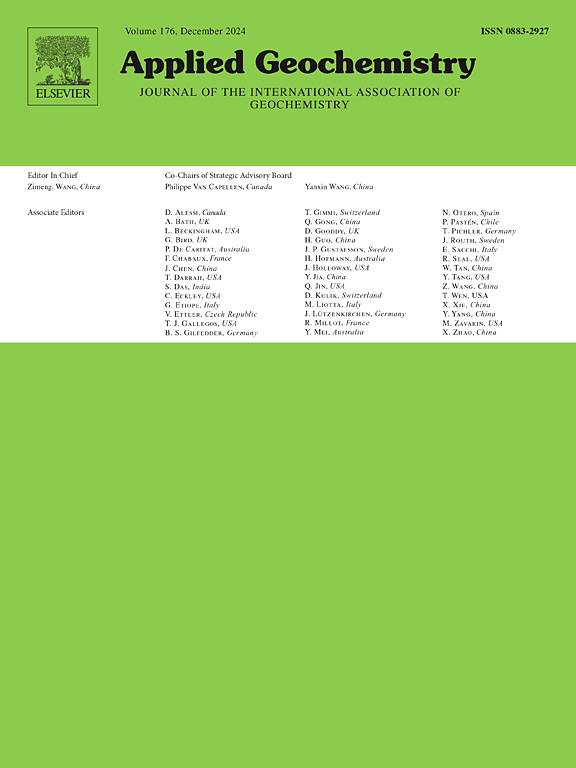Paleoenvironmental assessment of a lower Jurassic succession in the NW-German Basin employing DRIFTS
IF 3.4
3区 地球科学
Q1 GEOCHEMISTRY & GEOPHYSICS
引用次数: 0
Abstract
High-resolution reconstruction of paleoenvironmental conditions of sedimentation requires the qualitative and quantitative assessment of the major sediment-forming fractions, i.e., carbonate, clay, quartz and organic matter. Simultaneous determination of these sediment-forming fractions by cost-effective and rapid methodologies is difficult to achieve. Previously, either XRF-, XRD-, and microscopy-based methods, or combinations thereof have been employed, complemented by organic carbon analysis. We here present a simultaneous approximation of the most relevant sediment-forming constituents, carbonate, clay, and organic matter, as well as quartz and feldspar, if present in sufficient quantity, by Diffusive Infra-Red Fourier Transformation Spectroscopy (DRIFTS). The technique does not require elaborated sample preparation or large sample amounts and is conducted without analytical reagents, solvents or carrier gases, thereby allowing high sample through-put. As such, DRIFTS investigation is ideal for stratigraphically highly-resolved studies. We applied DRIFTS to a sediment succession of Pliensbachian/Toarcian age and differentiated six sedimentary facies intervals that previously had been established based on application of more sophisticated but also more cost- and time-affording methodologies like XRF, XRD and programmed pyrolysis. While having been applied previously to characterization of soils and kerogen concentrates, we here demonstrate applicability of the DRIFTS technique to analysis of pre-Quaternary and consolidated sedimentary sequences.

利用DRIFTS对德国西北部盆地下侏罗统演替进行古环境评价
古沉积环境条件的高分辨率重建需要对碳酸盐岩、粘土、石英和有机质等主要成沉积组分进行定性和定量评价。同时测定这些沉积物形成组分的成本效益和快速的方法是难以实现的。以前,采用XRF-, XRD-和基于显微镜的方法,或它们的组合,并辅以有机碳分析。在这里,我们通过漫射红外傅立叶变换光谱(DRIFTS)同时逼近最相关的沉积形成成分,碳酸盐,粘土和有机物,以及石英和长石,如果存在足够的数量。该技术不需要详细的样品制备或大量样品,并且不需要分析试剂,溶剂或载气进行,从而允许高样品吞吐量。因此,DRIFTS调查是地层学高分辨率研究的理想选择。我们将DRIFTS应用于Pliensbachian/Toarcian时代的沉积层序,并区分了6个沉积相层序,这些沉积相层序之前是基于XRF、XRD和程序化热解等更复杂但成本和时间更长的方法建立的。虽然以前已经应用于土壤和干酪根浓缩物的表征,但我们在这里证明了DRIFTS技术对分析前第四纪和固结沉积序列的适用性。
本文章由计算机程序翻译,如有差异,请以英文原文为准。
求助全文
约1分钟内获得全文
求助全文
来源期刊

Applied Geochemistry
地学-地球化学与地球物理
CiteScore
6.10
自引率
8.80%
发文量
272
审稿时长
65 days
期刊介绍:
Applied Geochemistry is an international journal devoted to publication of original research papers, rapid research communications and selected review papers in geochemistry and urban geochemistry which have some practical application to an aspect of human endeavour, such as the preservation of the environment, health, waste disposal and the search for resources. Papers on applications of inorganic, organic and isotope geochemistry and geochemical processes are therefore welcome provided they meet the main criterion. Spatial and temporal monitoring case studies are only of interest to our international readership if they present new ideas of broad application.
Topics covered include: (1) Environmental geochemistry (including natural and anthropogenic aspects, and protection and remediation strategies); (2) Hydrogeochemistry (surface and groundwater); (3) Medical (urban) geochemistry; (4) The search for energy resources (in particular unconventional oil and gas or emerging metal resources); (5) Energy exploitation (in particular geothermal energy and CCS); (6) Upgrading of energy and mineral resources where there is a direct geochemical application; and (7) Waste disposal, including nuclear waste disposal.
 求助内容:
求助内容: 应助结果提醒方式:
应助结果提醒方式:


